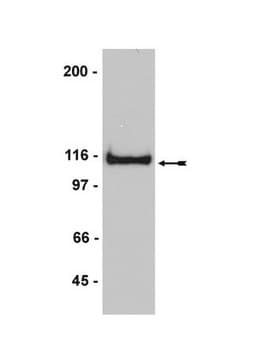05-593
Przeciwciało anty-α-Dystroglikan, klon IIH6C4
ascites fluid, clone IIH6C4, Upstate®
Synonim(y):
Dystrophin-associated glycoprotein 1, dystroglycan 1, dystroglycan 1 (dystrophin-associated glycoprotein 1), dystrophin-associated glycoprotein-1, LARGE-glycan, Large glycan
About This Item
Polecane produkty
pochodzenie biologiczne
mouse
forma przeciwciała
ascites fluid
klon
IIH6C4, monoclonal
reaktywność gatunkowa
human, mouse, canine, rat, guinea pig, rabbit
producent / nazwa handlowa
Upstate®
metody
immunofluorescence: suitable
immunohistochemistry: suitable
inhibition assay: suitable
western blot: suitable
izotyp
IgM
numer dostępu NCBI
numer dostępu UniProt
Warunki transportu
dry ice
docelowa modyfikacja potranslacyjna
unmodified
informacje o genach
human ... DAG1(1605)
Opis ogólny
Specyficzność
Immunogen
Zastosowanie
Analiza Western Blot: Poprzednia partia tego przeciwciała została użyta w lizacie tkanki mięśniowej myszy 3 miesiące po indukcji shRNA oraz w kontroli miotu (ctrl) i kontroli negatywnej LARGE-null (myd) (Goddeeris, M., et al. 2013, Nature).
Immunofluorescencja: Poprzednia partia tego przeciwciała została użyta do wykrycia α-dystroglikanu / glikanu LARGE w tkance mięśniowej myszy (Goddeeris, M., et al. 2013, Nature).
Metabolizm
Fizjologia mięśni
Jakość
Western Blot Analysis:
A 1:1000-1:2000 dilution of this lot detected α-Dystroglycan/LARGE-glycan in rabbit skeletal muscle.
Note: The use of WGA purified protein results in significantly cleaner blots and immunoprecipitates.
Post-translational modification of dystroglycan causes band broadening.
Opis wartości docelowych
Postać fizyczna
Ciecz w temperaturze -20ºC.
Przechowywanie i stabilność
Komentarz do analizy
Lizat mięśni szkieletowych królika.
Inne uwagi
Informacje prawne
Oświadczenie o zrzeczeniu się odpowiedzialności
polecane
Kod klasy składowania
12 - Non Combustible Liquids
Klasa zagrożenia wodnego (WGK)
WGK 2
Temperatura zapłonu (°F)
Not applicable
Temperatura zapłonu (°C)
Not applicable
Certyfikaty analizy (CoA)
Poszukaj Certyfikaty analizy (CoA), wpisując numer partii/serii produktów. Numery serii i partii można znaleźć na etykiecie produktu po słowach „seria” lub „partia”.
Masz już ten produkt?
Dokumenty związane z niedawno zakupionymi produktami zostały zamieszczone w Bibliotece dokumentów.
Active Filters
Nasz zespół naukowców ma doświadczenie we wszystkich obszarach badań, w tym w naukach przyrodniczych, materiałoznawstwie, syntezie chemicznej, chromatografii, analityce i wielu innych dziedzinach.
Skontaktuj się z zespołem ds. pomocy technicznej








